Aruba Certified Mobility Expert 8 Written Exam v1.0
Question 1
Refer to the exhibit.
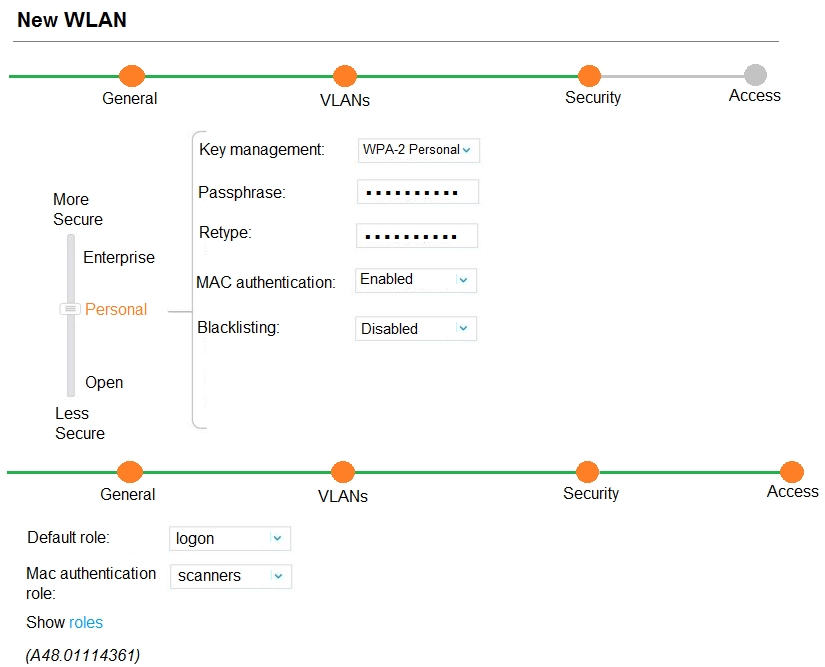
A company acquires ten barcode scanners to run inventory tasks. These Wifi devices support WPA2-PSK security only. The network administrator deploys a
WLAN named scanners using the configuration shown in the exhibit.
What must the network administrator do next to ensure that the scanner devices successfully connect to their SSID?
- A. Add scanner MAC addresses in user derivation rules.
- B. Add scanner MAC addresses in the internal database.
- C. Set internal as the MAC authentication server group.
- D. Enable L2 Authentication Fail Through.
Answer : C
Question 2
Refer to the exhibits.
Exhibit 1 -
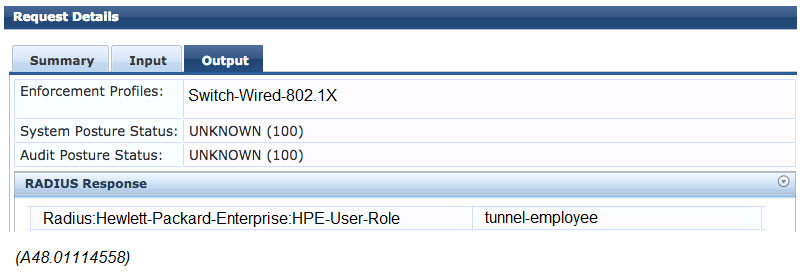
Exhibit 2 -
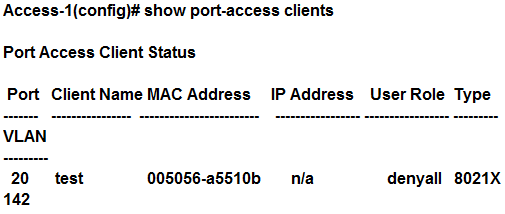
A network administrator deploys role-based tunneled node in a corporate network to unify the security policies enforcement. When users authenticate with 802.1X,
ClearPass shows Accept results, and sends the HPE-User-Role attribute as expected. However, the switch always applies the denyall role.
Why does the switch fail to allocate the tunnel-employee role?
- A. Denyall is a secondary role contained within tunnel-employee.
- B. The switch is not configured with primary tunneled-node user role.
- C. The switch is not configured with secondary tunneled-node user role.
- D. RADIUS Access Accept messages time out in the switch.
Answer : B
Question 3
A company currently offers guest access with an open SSID and no authentication. A network administrator needs to integrate a web login page for visitors.
To accomplish this integration, the network administrator fully deploys a guest solution with self-registration in ClearPass, and defines the Mobility Controller (MC) as a RADIUS client. Then, the network administrator defines ClearPass as a RADIUS server and adds it into a server group in the MC.
Which two actions must the network administrator do next on the MC side to complete the deployment? (Select two.)
- A. Associate the captive portal profile to the initial role
- B. Define the web login URL and server group in a captive portal profile
- C. Associate the captive portal profile to the VAP profile
- D. Associate the captive portal to an AAA profile.
- E. Define the web login URL in a captive portal profile and the server group in an AAA profile.
Answer : BD
Question 4
Refer to the exhibit.
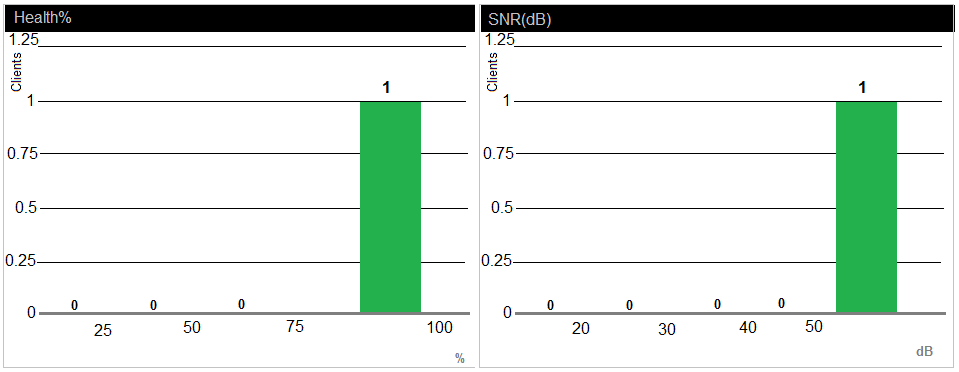

A network administrator receives a call from a contractor that was recently given wireless access to the network. The user reports that the response time is slow and suggests there might be a problem with the WLAN. The network administrator checks RF performance in AirWave to find the user and sees the output shown in the exhibit.
What can the network administrator conclude after analyzing the data?
- A. Client health and CNR are high, therefore, it is unlikely the client is experiencing an RF-related issue.
- B. Goodput is low in relation to connection speed, which suggests a channel with high utilization, another channel should be used.
- C. Client health and SNR are high but usage is low; therefore, there might be packet drops.
- D. Client health is low, which suggests that there are packet drops and collisions in the RF environment.
Answer : B
Question 5
Refer to exhibit.
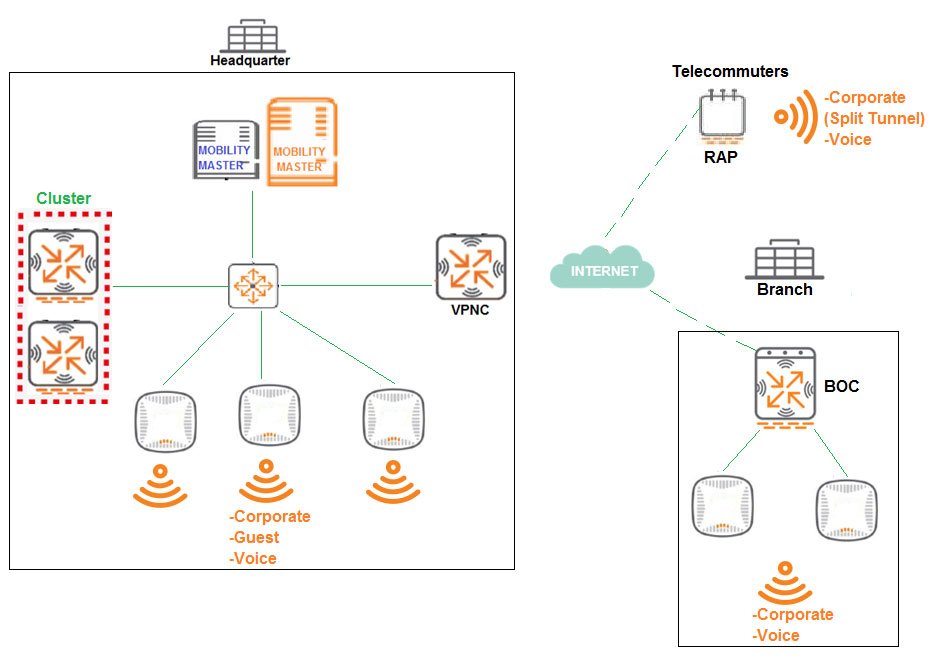
A company has a multiple Arua implementation with three different locations named Headquarter, Branch, and Telecommuters.
The network design includes the following:
-> Headquarter APs terminate at the Mobility Controller (MC) cluster and propagate Corporate, Guest, and Voice SSIDs
-> Branch APs terminate at the Branch Office Controller (BOC) and propagate Corporate and Voice SSIDs
-> BOC reaches the Mobility Master (MM) through a VPNC.
-> Telecommuter RAPs terminate at VPNC and propagate Corporate and Voice SSIDs.
-> The Corporate SSID on the RAPs is split-tunnel, all other SSIDs are tunnel.
The network design requires minimal AP group and VAP configuration effor, while preventing unnecessary VAP propagation to lower hierarchy levels.
Following Aruba node hierarchy desing recommendations, which group hierarchy design helps meet these requirements?
- A. /md /md/Corp1/ /md/Corp1/Offices /md/Corp1/Offices/Headquarter /md/Corp1/Offices/Branch /md/Corp1/Telecommuters /mm /mm/mynode
- B. /md /md/Headquarter /md/Branch /md/Telecommuters /mm /mm/mynode
- C. /mm /md/Locations /md/Locations/Headquarter /md/Locations/Branch /md/Locations/Telecommuters /mm /mm/mynode
- D. /md /md/Location1/ /md/Location1/Branch /mdLocation1/Offices /md/Location1/Offices/Headquarter /md/Location1/Telecommuters /mm /mm/mynode
Answer : D
Question 6
Refer to the exhibit.
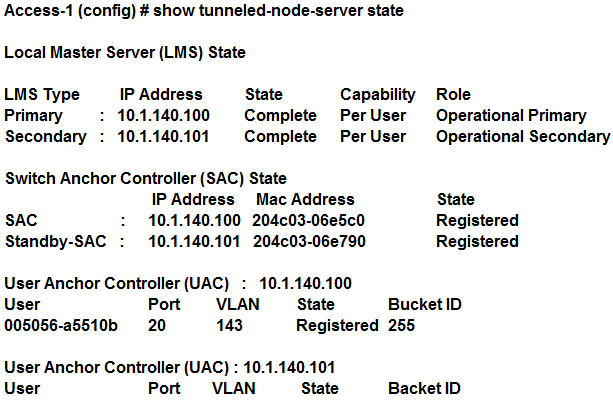
Based on the output shown in the exhibitm with which Aruba devices has Access-1 established tunnels?
- A. a pair of MCs within a cluster
- B. a single standalone MC
- C. a pair of MCs with APFF enabled
- D. a pair of switches
Answer : B
Question 7
A foreign exchange broker in a shared office space uses an Aruba Mobility Master (MM)-Mobility Controller (MC) architecture along with ClearPass and AirWave.
The corporate network is FXBroker121, but users report that they cannot access the FXBroker111 SSID. The team suspects that a rogue AP is in place and a malicious user tried to disguise the WLAN name.
How can the organization"™s network administrator identify and locate the potential rogue AP?
- A. Create an AirWave RAPIDS rule with a Suspected Rogue classification and the SSID Matches FXBroker111 condition, then access any RAPID List entry that matches the rule and click on Location.
- B. Use ClearPass Event viewer and search for entries with the FXBroker111 Aruba-Essid-Name VSA attribute, then obtain the value of the Aruba-AP-Group attribute.
- C. Use ClearPass Event viewer and search for entries with the FXBroker111 Aruba-Essid-Name VSA attribute, then obtain the value of the Aruba-Location-id attribute.
- D. Create and AirWave RAPIDS rule with a Suspected Rogue classification and the SSID Does Not Match FXBroker121 condition, then access any RAPIDS List entry that matches the rule and click on Location.
Answer : B
Question 8
Refer to the exhibit.
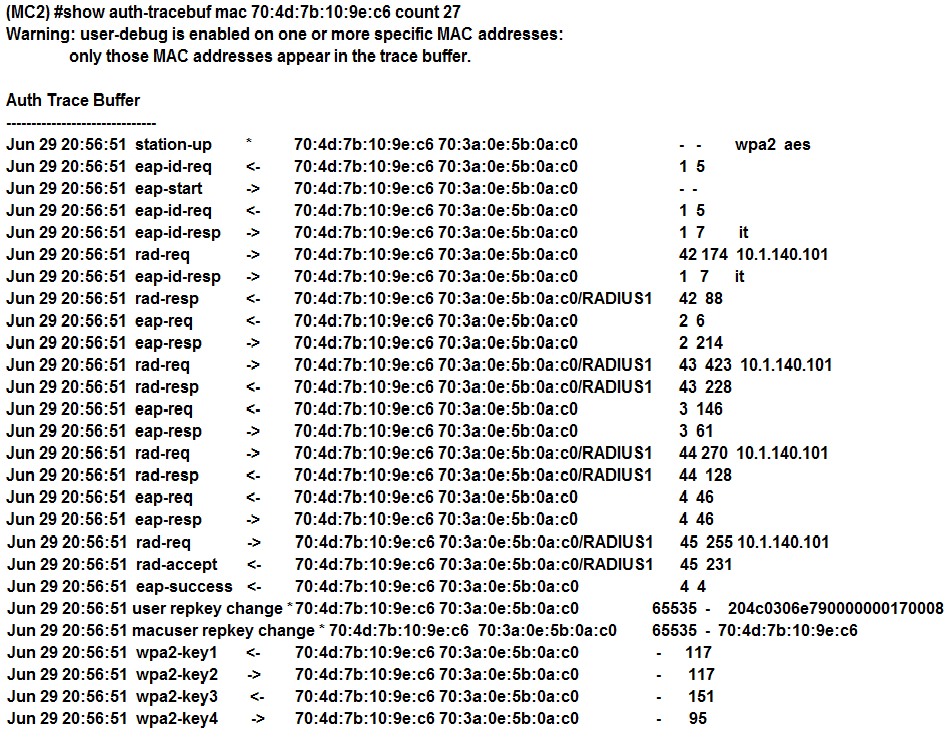
A network administrator is validating client connectivity and executes the show command shown in the exhibit. Which authentication method was used by the wireless station?
- A. 802.1X user authentication
- B. EAP authentication
- C. 802.1X machine authentication
- D. MAC authentication
Answer : C
Question 9
A network administrator deplos a guest solution over WiFi and creates a corp_guest role for this purpose. The network administrator must configure the solution with a custom policy that permits visitors to get an IP address, perform DNS resolutions, and get internet access while blocking any attempt to reach internal resources at the 10.0.0.0/8 network. The solution should prevent visitors from acting as rogue DHCP servers, then blacklist and log the attempt if this ever happens.
Which setup meets these requirements?
- A. netdestination corporate_network network 10.0.0.0 255.0.0.0 ip access-list session corp_guests user any udp 68 deny log blacklist any any svc-dhcp permit user alias coroporate_network deny user any any permit user-role Corp_guest access-list session corp_guests
- B. netdestination corporate_network network 10.0.0.0 255.0.0.0 ip access-list session corp_guests any any udp 68 deny log blacklist any any svc-dhcp permit user alias coroporate_network deny user any any permit user-role Corp_guest access-list session corp_guests
- C. netdestination corporate_network network 10.0.0.0 255.0.0.0 ip access-list session corp_guests user any udp 67 deny log blacklist any any svc-dhcp permit user alias coroporate_network deny user any any permit user-role Corp_guest access-list session corp_guests
- D. netdestination corporate_network network 10.0.0.0 255.0.0.0 ip access-list session corp_guests any any udp 67 deny log blacklist any any svc-dhcp permit user alias coroporate_network deny user any any permit user-role Corp_guest access-list session corp_guests
Answer : A
Question 10
Refer to the exhibits.
Exhibit 1 -
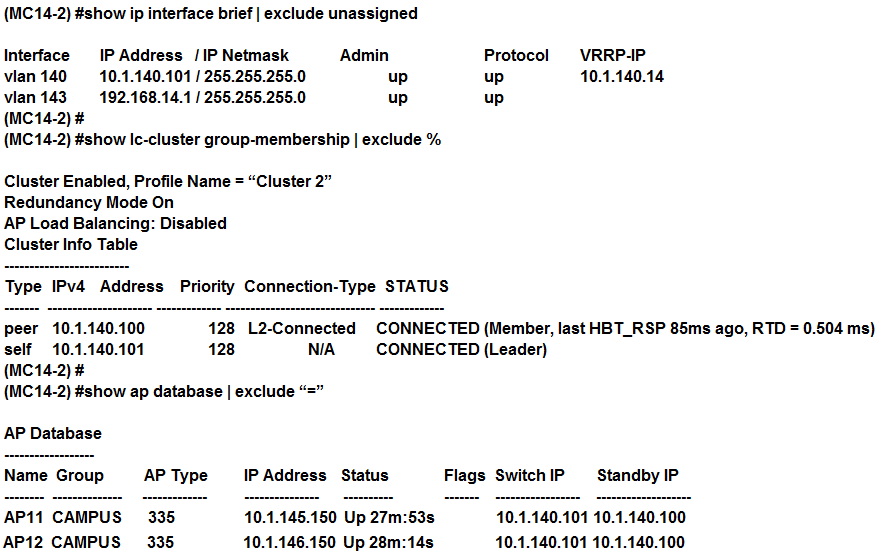
Exhibit 2 -
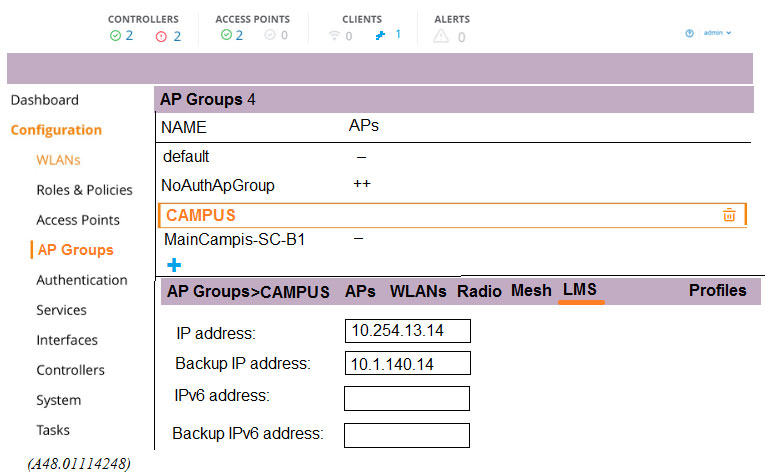
A network administrator deploys a test environment with two Mobility Masters (MMs), two two-member Mobility Controller (MC) clusters, and two CAPs, with the intention of testing several ArubaOS features, Cluster members run VRRP for AP boot redundancy. Based on the information shown in the exhibits, what is the current status of the APs?
- A. APs are currently communicating with LMS IP, and 10.1.140.100 is S-AAC.
- B. APs are currently communicating with BLMS IP, and 10.1.140.101 is A-AAC.
- C. APs are currently communicating with BLMS IP, and 10.1.140.101 is S-AAC.
- D. APs are currently communicating with BLMS IP, and 10.1.140.100 is A-AAC.
Answer : B
Question 11
Refer to the exhibit.

A network administrator wants to configure an 802.1x supplicamt for a wireless network that includes the following:
-> AES encryption
-> EAP-MSCHAP v2-based user and machine authentication
-> Validation of server certificate in Microsoft Windows 10
The network administrator creates a WLAN profile and selects the change connection settings option. Then the network administrator changes the security type to
Microsoft: Protected EAP (PEAP), and enables user and machine authentication under Additonal Settings.
What must the network administrator do next to accomplish the task?
- A. Enable user authentication under Settings.
- B. Change the security type to Microsoft. Smart Card or other certificate.
- C. Enable server certificate validation under Settings.
- D. Enable computer autentication under Settings.
Answer : B
Question 12
A network administrator wants to receive a major alarm every time a controller or an Aruba switch goes down for either a local or an upstream device failure.
Which alarm definition must the network administrator create to accomplish this?
A.
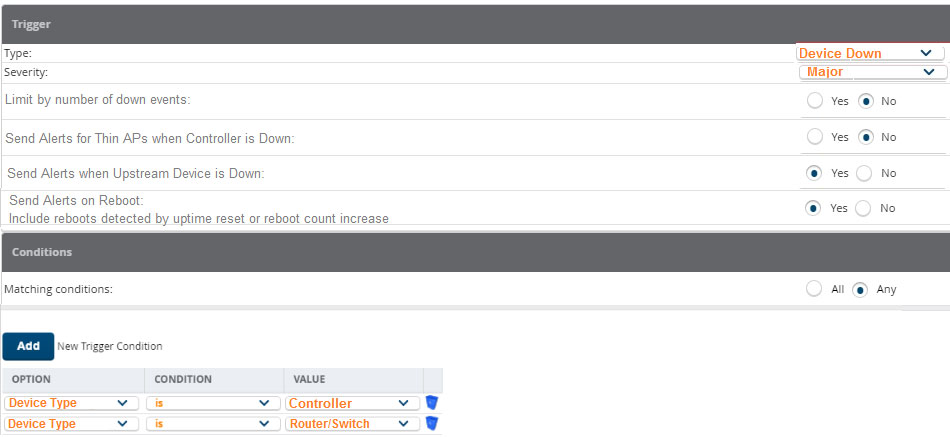
B.
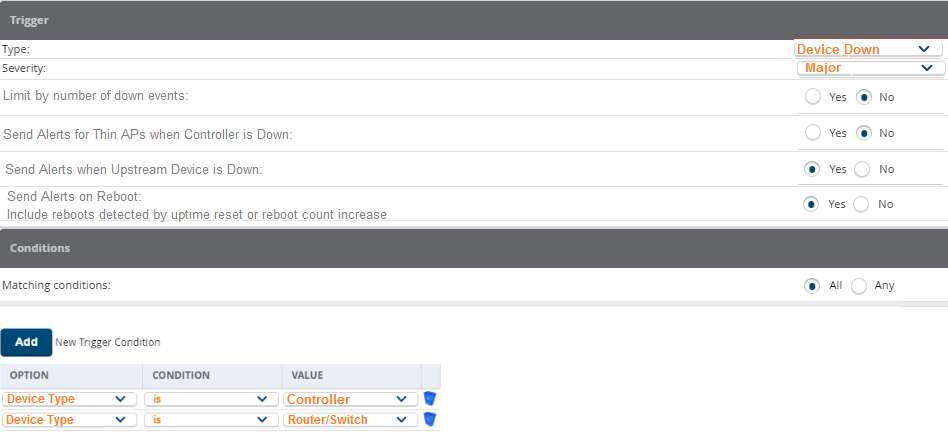
C.
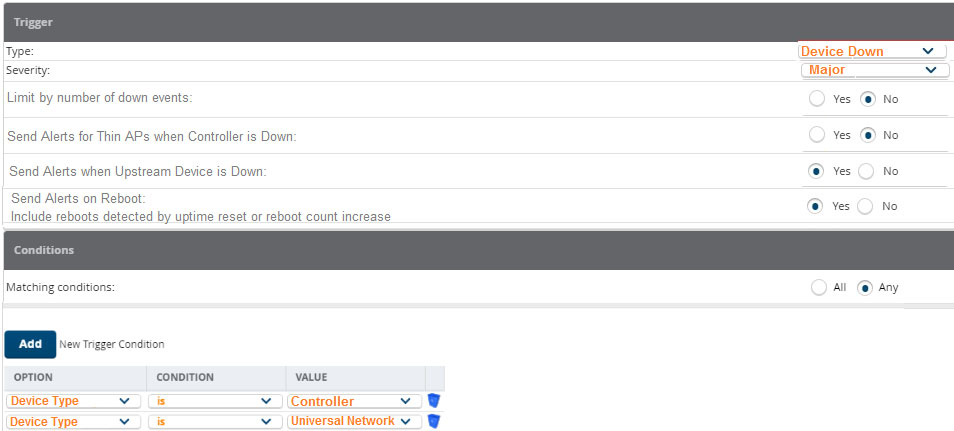
Answer : B
Question 13
Refer to the exhibit.
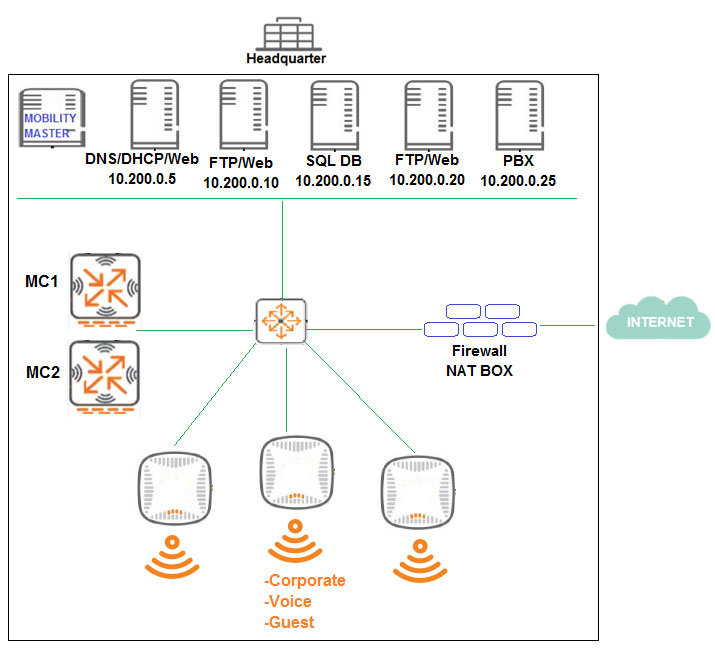
An organization provides WiFi access through a corporate SSID with an Aruba Mobility Master (MM)-Mobility Controller (MC) network that includes PEF functions.
The organization wants to have a single firewall policy configured and applied to the employee role.
This policy must allow users to reach Web, FTP, and DNS services, as shown in the exhibit. Other services should be exclusive to other roles. The client NICs should receive IP settings dynamically.
Which policy design meets the organization"™s requirements while minimizing the number of policy rules?
- A. netdestination alias1 host 10.200.0.10 host 10.200.0.20 ip access-list session policy1 user host 10.200.0.5 svc-dns permit user host 10.200.0.5 svc-http permit user alias alias1 svc-http permit user alias alias1 svc-ftp permit
- B. netdestination alias1 host 10.200.0.5 host 10.200.0.10 host 10.200.0.20 netdestination alias2 host 10.200.0.10 host 10.200.0.20 ip access-list session policy1 any any svc-dhcp permit user host 10.200.0.5 svc-dns permit user alias alias1 svc-http permit user alias alias2 svc-ftp permit
- C. netdestination alias1 host 10.200.0.10 host 10.200.0.20 ip access-list session policy1 any any svc-dhcp permit user host 10.200.0.5 svc-dns permit user host 10.200.0.5 svc-http permit user alias alias1 svc-http permit user alias alias1 svc-ftp permit
- D. netdestination alias1 host 10.200.0.5 host 10.200.0.10 host 10.200.0.20 netdestination alias2
Answer : C
Question 14
Refer to the exhibits.
Exhibit 1 -

Exhibit 2 -
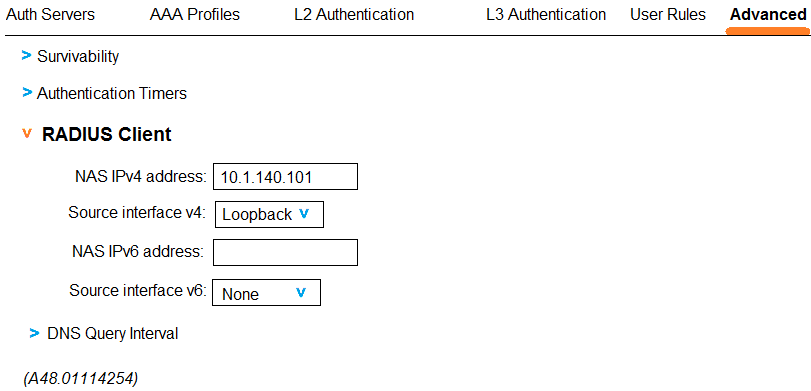
Exhibit 3 -
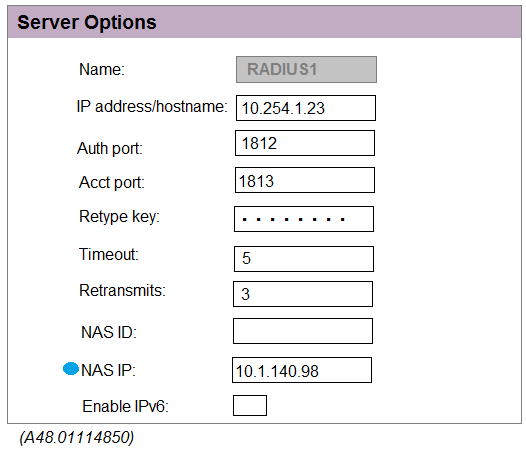
A network administrator must ensure that a ClearPass server can receive the RADIUS authentication request from a single Mobility Controller (MC) managed by a
Mobility Master (MM). Based on the exhibits, what is the value of NAS-IP contained in the RADIUS access requests?
- A. 10.1.140.98
- B. 10.1.140.99
- C. 10.1.140.100
- D. 10.1.140.101
Answer : A
Question 15
Refer to the exhibit.

A network administrator completes the task to cretae a WLAN, as shown in the exhibit. The network administrator selects the options to use guest as primary usage and Internal captive portal with authentication in the security step. Next, the network administrator creates a policy that denies access to the internal network.
Which additional step must the network administrator complete in order to prevent authenticated users from reaching internal corporate resources while allowing
Internet access?
- A. Apply the policy on the guest-guest-logon role.
- B. Apply the policy on the authenticated role.
- C. Apply the policy on the guest role.
- D. Create a policy that permits dhcp, dns, and http access.
Answer : D